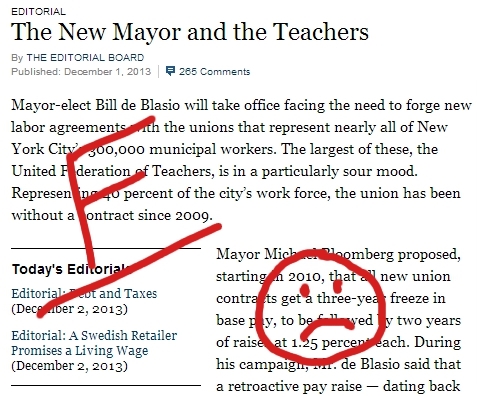NEW YORK » NYT EDITORIALS
The New York Times Gets an ‘F’ on Education Policy
December 4, 2013 · 0 Comments

By Ann Robertson and Bill Leumer:
A recent New York Times editorial took a moment out to lecture mayor-elect of New York City Bill de Blasio on how he should treat teachers and their unions. We hope he doesn't listen.
The editorial began by endorsing a pay raise for New York City teachers, but insisted that “any sort of raise will require concessions in exchange,” including loosening “work rules that stifle innovation and favor senior teachers over younger ones who may in fact be more talented.” This general philosophy was spelled out on a number of different fronts.
For example, the editorial continued:
Seniority trumps everything and is treated as a proxy for excellence. Under current rules, a school that has an enrollment shortfall or budget problem and has to cut one of its five math teachers cuts the least senior teacher, period. In progressive systems, like the one in Washington, D.C., which has made big gains on federal assessment tests, decisions about which teachers to cut are based on a combination of factors, including how they stack up on evaluations and whether they possess special skills. The goal is to keep the most talented teachers.
There are a number of problems here. First, the New York Times editorial board is simply accepting – no questions asked – that in the richest country in the world it makes sense for schools to cut teachers because of a “budget problem.” The U.S. is engaged in an insane, entirely irrational campaign of underfunding its public schools on a massive basis, thereby robbing the country of the benefit of a future well-educated citizenry. How the New York Times expects any teacher to succeed in nurturing critically thinking students, when they are surrounded by policy makers who lack any semblance of logic and who give corporations generous tax breaks rather than adequately fund schools, is at least, questionable.
Second, according to the statement above, Washington, D.C. “has made big gains on federal assessment tests,” but in a past New York Times article, the Washington, D.C. test scores looked suspect. Here is what was reported on August 21, 2011:
At the end of March, three of the paper’s [USA Today] reporters — Marisol Bello, Jack Gillum and Greg Toppo — broke a story about the high rate of erasures and suspiciously high test-score gains at 41 Washington schools while Ms. Rhee was chancellor.
At some schools, they found the odds that so many answers had been changed from wrong to right randomly were 1 in 100 billion.
Third, even if Washington, D.C. test scores were accurate, and 1 chance in a 100 billion sounds remote, there is a problem with evaluating teachers on the basis of standardized test scores. As New York Times columnist Joe Nocera reported (April 25, 2011):
“Going back to the famous Coleman report in the 1960s, social scientists have contended — and unquestionably proved — that students’ socioeconomic backgrounds vastly outweigh what goes on in the school as factors in determining how much they learn.” In other words, the real cause of so much educational failure is not poor teaching; it is poor neighborhoods. But in a society in which 95 percent of all new wealth goes to the wealthiest 1 percent, nothing short of a fundamental social transformation will address that problem.
The New York Times editorial continues: “Similarly, the salary schedule in New York is calculated to reward longevity, requiring 22 years to get to the top level.” And it added shortly thereafter: “Meanwhile, younger teachers start out with relatively low salaries and are at risk of leaving the system for higher pay elsewhere. The scales should be rebalanced so that teachers who are judged highly effective under the new evaluation system can move up quickly in the pay scale.”
Again, their statement is riddled with problems. Excellent teachers do not go into teaching for the money. Rather, they love to learn, they love to teach, and they love their students. The deep rewards they derive from teaching are completely untouched by money. Of course, it is possible to force even excellent teachers to re-evaluate their priorities by paying them poverty wages, which they would probably be getting were it not for the strong teacher unions. But no one should be paid poverty wages; every hard-working individual deserves a sufficient salary so that they are in a position to buy a house, a car, send their children to college, receive quality health care, and retire with dignity.
Even granting that excellent teachers could be unambiguously identified, the merit pay being peddled by the New York Times will undermine quality education rather than promote it. It makes teachers compete against one another for rewards, thereby destroying a sense of camaraderie among them; it insinuates that material rewards are of the highest importance, not pleasures of the mind; and it militates against the development of a community of minds that in the final analysis is the most powerful tool for the pursuit of knowledge.
Furthermore, who determines who is an excellent teacher? If standardized test scores do not provide an infallible index, then who decides? This indispensable and unavoidable question is never broached by the New York Times editorial board. In fact, in most cases principals are the deciders, but they are often the people who fled the classroom themselves because they were more interested in money than in teaching, hardly a strong qualification for allowing them to discern excellent teachers.
When given the chance, however, teachers and principals together can solve the problem of evaluations. The Montgomery County public school system in Rockville, Maryland, with an excellent teaching record, has a highly regarded approach to teacher evaluations. They have created a panel of eight teachers and eight principals to evaluate teachers collectively. Importantly, everyone on the panel has an equal voice, and decisions are arrived at through a process of rational argumentation and democratic voting. But there was a special key to the panel’s success. As the teachers’ union president said: “It wouldn’t work without the level of trust we have here.” This trust could never develop in system with merit pay.
Finally, the editorial argues: “The teachers’ union has been particularly hostile to the city’s thriving charter schools, which receive public financing, are exempt from some state rules and regulations, and, on average, are outperforming traditional schools.”
But the same New York Times editorial board had this to say earlier this year about charter schools: “Despite a growing number of studies showing that charter schools are generally no better — and often are worse — than their traditional counterparts, the state and local agencies and organizations that grant the charters have been increasingly hesitant to shut down schools, even those that continue to perform abysmally for years on end.”
The hostility of the teachers’ union towards charter schools looks immanently rational compared to this year’s incoherency of the Times editorial board.
Ann Robertson is a Lecturer at San Francisco State University and a member of the California Faculty Association. Bill Leumer is a member of the International Brotherhood of Teamsters, Local 853 (ret.). Both are writers for Workers Action and may be reached at [email protected]
By admin










Sorry, comments are closed on this post.